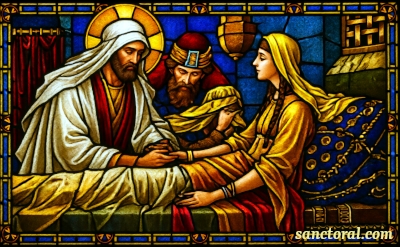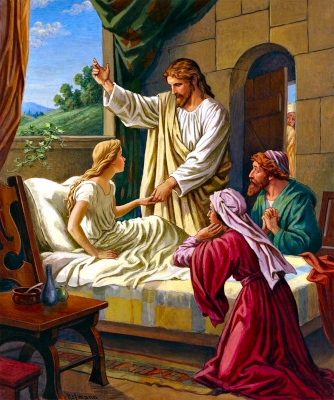After the Jews had been carried captive into Babylon, Jeremias wandered among the ruins of Jerusalem, uttering his lamentations. “Regard, O Lord, how doth the city sit solitary that was full of people! How is the mistress of the Gentiles become as a widow... Weeping she hath wept in the night and her tears are on her eheeks” (Third responsory at Matins for the first Sunday in November). But he goes on to foretell the twofold coming of the Messias who will restore all things. “The Lord hath redeemed His people and delivered them; and they shall come and give praise in Mount Sion, and they shall flow together to the good things of the Lord” (Jeremias 31. 11-12). Among those who had been carried captive into Babylon was a priest named Ezechiel who had foretold the captivity which was to overtake Israel. In exile, he prophesied further: “As I live, saith the Lord God, I desire not the death of the wicked, but that the wicked turn from his way and live. Turn ye, turn ye, from your evil ways: and why will you die, O house of Israel?” (Ezechiel 23. 10-11). And God showed the prophet the future Temple established on a high mountain, pointing out to him how perfect would be the worship He would expect from His people when He had gathered them once more to the eternal hills of Sion. Again, Darnel, also one of the captives in Babylon, explained Nabucho- donosor’s dream in the sense that the little stone which became a great mountain after having overturned the statues of God, Silver, Iron and Clay is a symbol of Christ whose kingdom shall supersede all kingdoms and last forever. Among the Minor Prophets Osee is the one of whom most use is made in the official worship of the Church (in the fourth Week in November). He foretold that God would bring to an end the kingdom of Israel, and that it would be said to a people that was not His people: “Ye are the sons of the living God. And the children of Israel and the children of Juda shall be gathered together, and they shall appoint themselves one head.” St. Augustine interprets these words as a prophecy of the calling of the Gentiles and the definitive gathering together of Jews and Gentiles at the end of the world into one great people redeemed by Christ. These prophecies shed considerable light on the proper of to-day’s Mass. The Introit is taken from Jeremias who foretells the end of a captivity of which Babylon was only a type. This thought should be a source of great encouragement to us; a day will come which will mark the end of our exile and the Church, by reminding us of it, takes care to assure us that “the Lord’s thoughts are thoughts of peace.” The Gradual is a chant of deliverance. The “De profundis” of the Alleluia, repeated again in the Offertory, is an appeal sent up in time of distress, but confident of being heard (Communion). In the Epistle St. Paul calls on us to give up our desire for earthly things and to attach ourselves to those of heaven; in suchwise we may five in heaven already: “our conversation is in heaven, from whence also we look for the Saviour..." The Church, repeating the Apostle’s appeal, requires us to “stand fast in the Lord” and not unmindful of human weakness makes us implore from God the pardon of our sins and His help to enable us to avoid falling into them again (Collect and Postcommunion). The Gospel is the account of a cure and the raising of a body from the dead: it, too, is an illustration of the great mercy and power of God. The end of the world as well as a manifestation of divine justice will be the revelation of that incomparable redemption which Christ’s miracles have allowed us to glimpse here below, but which will only be seen in its full extent and greatness at the last day. We should remember that we are closely concerned with this great work of salvation and that it is brought into play on our behalf. With the Church we should ask God to vouchsafe in His goodness that what He has begun in us His unworthy servants He will mercifully complete. (Saint Andrew Daily Missal with Vespers for Sundays and Feasts, by Dom Gaspar Lefebvre, O.S.B. of the Abbey of St. André, 1953) (Jer. 29:11-14) The Lord saith: I think thoughts of peace, and not of affliction: you shall call upon Me, and I will hear you; and I will bring back your captivity from all places. (Ps.) Lord, Thou hast blessed Thy land: Thou hast turned away the captivity of Jacob. Gloria Patri. Absolve, we beseech Thee, O Lord, the sins of Thy people; that we may be delivered by Thy goodness from the bonds of sins, which by our frailty we have committed. Through our Lord... Lesson of the Epistle of Saint Paul the Apostle to the Philippians (3:17-21; 4:1-3) (Ps. 43:8-9) Thou hast delivered us, O Lord, from them that afflict us: and hast put them to shame that hate us. ℣. In God we will glory all the day: and in Thy name we give praise for ever. Alleluia, Alleluia. ℣. (Ps. 129:1-2) From the depths I have cried to Thee, O Lord: Lord, hear my prayer, Alleluia. Sequel of the holy Gospel according to Matthew (9:18-26) (Saint Andrew Daily Missal with Vespers for Sundays and Feasts, by Dom Gaspar Lefebvre, O.S.B. of the Abbey of St. André, 1953)Twenty third Sunday after Pentecost - Resurrection of Jairus’ daughter

Table of Contents
Reflexions on the Liturgy of the Day
The Time after Pentecost is the symbol of the Church’s long pilgrimage towards heaven, the last stages of which are described in prophetic language on these closing Sundays of the season. The breviary lessons during November are taken from the Major and Minor Prophets who foretell the events which will mark the end of the world.
Liturgy of the Mass
Introit
Collect
This Epistle is an urgent exhortation to a mortified life entirely directed towards heaven, the real home of Christians. To live the life of Christ, as far as possible, here below, is the best preparation for eternal life. Epistle
Brethren, be followers of me, and observe them who walk so as you have our model. For many walk, of whom I have told you often (and now tell you weeping) that they are enemies of the cross of Christ; whose end is destruction, whose God is their belly, and whose glory is in their shame; who mind earthly things. But our conversation is in heaven, from whence also we look for the Saviour, our Lord Jesus Christ, who will reform the body of our lowness, made like to the body of His glory, according to the operation whereby also He is able to subdue all things unto Himself. Therefore, my brethren, dearly beloved, and most desired, my joy and my crown: so stand fast in the Lord, my dearly beloved: I beg of Evodia, and I beseech Syntyche to be of one mind in the Lord: and I entreat thee also, my sincere companion; help those women who have laboured with me in the Gospel, with Clement and the rest of my fellow-labourers, whose names are in the book of life.Gradual
Jesus raises Jairus’ daughter from the dead as easily as we arouse a sleeping person. So will His divine power raise up our bodies at the last Day. 
Gospel
At that time, as Jesus was speaking to the multitudes, behold a certain ruler came up, and adored Him, saying: Lord, my daughter is even now dead; but come lay Thy hand upon her, and she shall live. And Jesus, rising up, followed him, with His disciples. And behold a woman, who was troubled with an issue of blood twelve years, came behind Him, and touched the hem of His garment. For she said within herself: If I shall touch only His garment, I shall be healed. But Jesus turning and seeing her, said: Be of good heart, daughter, thy faith hath made thee whole. And the woman was made whole from that hour. And when Jesus was come into the house of the ruler, and saw the minstrels and the multitude making a tumult, He said: Give place; for the girl is not dead, but sleepeth. And they laughed Him to scorn. And when the multitude was put forth, He went in, and took her by the hand. And the maid arose. And the fame thereof went abroad into all that country. Credo